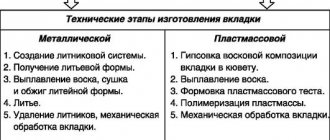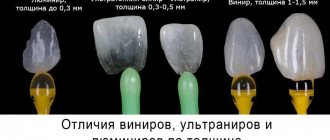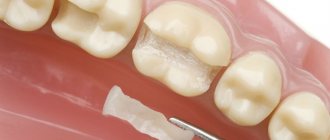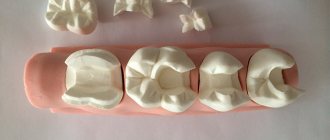Sometimes patients ask dentists: which is better, a pin or an inlay, and what is better to restore a damaged tooth? Despite the fact that these structures are somewhat similar and are intended for the same purpose - restoring severely damaged teeth while preserving their own roots - they still have a number of differences. To make it easier for the patient to decide, we will analyze the pros and cons of pins and inlays.
Content
- Details about the pin
- Details about the tab
- Materials for production
- What the inlay and pin have in common
- Differences
- What to choose - pin or tab
Currently, dentists offer many options for prosthetics and dental treatment. Modern technologies can solve almost any problem. It is important to choose the best option for a particular case. If treatment of a decayed tooth is required, the choice is between an inlay and a pin.
PROMOTION
Dental restoration, installation of fillings
from 2200 rub.
Advantages and disadvantages of using stump inlays
The main advantage of stump pin inlays is the high reliability and durability of prosthetics. This design will firmly hold the installed dental prosthesis and, moreover, will allow for proper distribution of the chewing load. When using pin stump inlays, the risk of crown loss is reduced to zero.
Installing crowns on the stump inlay and pin allows you to increase the useful life of the prosthesis. In addition, core inlays help to obtain the ideal tooth shape and are suitable for restoration of anterior and chewing teeth.
There are only two disadvantages to the use of stump inlays - higher price and longer prosthetic time. On average, it takes about 2 weeks to make an inlay.
IMPORTANT: Only an experienced prosthetist can make a high-quality multi-root collapsible stump inlay. Therefore, it is so important to choose a clinic for your treatment that employs competent and qualified orthopedists and dental technicians and has its own, well-equipped dental laboratory. Our dentistry in Moscow, Firadent, 100% meets these conditions: your treatment with us will be carried out with impeccable quality and comfort!
Pin
This is a rod installed in the root of the tooth to strengthen it and ensure subsequent treatment. It is installed when there is severe destruction, when no more than half of the root remains. The materials used for manufacturing are polymers or metals. A serious disadvantage of metal pins is the need to greatly expand the root canal, as a result of which its strength decreases. Fiberglass pins do not have this drawback and are similar in characteristics to natural dentin.
When choosing a manufacturing material, we proceed from specific requirements:
- For prosthetics of the front teeth, fiberglass is used;
- Metal products are intended for chewing units with severe destruction;
- Carbon fiber is a universal option, suitable for any teeth.
There are two types of fastening:
- Passive – on dental cement, without load on the root;
- Active - the pin is screwed into the root using a thread.
Anchor pins
A great variety of anchor pins are used in dentistry:
- by material of manufacture: titanium, steel, brass, fiberglass;
- according to the method of fixation: active (with an active sharp thread, like a self-tapping screw), passive (smooth, stepped ribbed) and something in between (with a smooth blunt thread);
- in shape: cylindrical and conical (with different tapers);
- In addition, each manufacturer produces pins of its own original design in different sizes and claims that its pins fit all pins.
But such diversity does not confuse dentists. Anchor pins appeared on the Russian market quite a long time ago, and each of us already clearly understands the indications and contraindications for this or that type of pin. Anchor pins significantly expand the dentist’s capabilities and can be used both for tooth restoration using photopolymer material, and for restoring the “stump” of a tooth for a crown.
Tab
This is also a prosthetic design that imitates part of a tooth. Used for teeth located behind the canine teeth.
There are:
- Restorative inlays - to recreate the correct shape, bite and natural shade of the tooth;
- Stump inlays are placed under the crown and serve as the foundation for it.
The difference from the pin is in the device - the inlays consist of two parts - the pin itself and an element that replicates the tooth. The manufacturing process takes place under pressure at high temperatures. The root part is an attachment for the root and looks like a rod. The upper element follows the shape of a crown.
Comparing methods: which is better - a stump tab or a pin
So, the question arises, which is better - a stump or a pin? We conducted a brief analysis by comparing the advantages and disadvantages of both prosthetic methods. All characteristics, pros and cons are placed in the table for convenience.
| Pin | Stump tab | |
| Number of doctor visits | 1 visit | 2 visits – during the first, impressions are taken and the tooth is prepared |
| Manufacturing | Pins are template structures | Inlays are created individually in the laboratory |
| Materials | Alloys of inexpensive metals | Ceramics, metal alloys, precious metals, zirconium dioxide |
| Possibility of developing allergies | High | Low, since hypoallergenic materials can be selected |
| Possibilities of prosthetics | The crown is built up on a post using composite materials | Various materials are used: composite building, or crowns (metal-ceramics, ceramics, zirconium dioxide) |
| Aesthetics of prosthetics | Medium – the metal base will be visible, the extended tooth will be noticeably darker | Very high due to the exact repetition of tooth anatomy and the choice of snow-white aesthetic materials |
| Main advantages | Affordable price, possibility of crown repair directly in the patient’s mouth | Root protection from destruction, high aesthetics, long service life |
| Main disadvantages | Rapid destruction of the root under load, relative aesthetics, short service life | High price |
| Life time | No more than 3-5 years | From 3-5 years and above |
| Price | From 4-5 thousand rubles including extensions | From 10 thousand rubles + crown |
To summarize, then, of course, it is worth giving preference to stump inlays. Such dentures ensure the reliability and functionality of the restored tooth. They can last for decades and the tooth will look like a natural one. But inlays are noticeably more expensive, so you need to make a choice primarily based on the condition of the tooth and your budget.
Material of manufacture
A variety of materials can be used, including:
- Metals and composites are the most popular option, they are easy to manufacture, durable and have an affordable price;
- Ceramic - similar to natural tooth enamel, the most aesthetic option;
- Zirconium - combines the best qualities of the previous options - they are aesthetically pleasing and durable, but are not very popular because they are very expensive.
A progressive method that wins
Until recently, the stump pin inlay for a tooth was not used in dentistry.
All reconstructions were fastened with conventional pins. They were extremely popular, they were widely advertised (mainly, of course, by manufacturing companies). The main advantages declared by sellers: the ability to facilitate and speed up the restoration process. Yes, indeed, the doctor used a standard composite reinforced with one or two anchor pins and performed the restoration in 1 session. It seemed that such a design would last forever; it surpassed its warranty period with dignity. But only 2-3 years passed and it collapsed, as the thin walls of the tooth quickly deformed from excessive load. The dentist could fix everything if it was a single crown, but if it was part of a multi-link bridge, the task became more complicated. One way or another, dentistry is actively developing and not so long ago a new device appeared - a stump pin insert. Initially, the tooth inlay did not gain much popularity, as it had a number of disadvantages (its production took longer, and the installation process was complex). Doctors, in order not to waste their time, tried not to advertise this opportunity to patients. But time has passed and now these stump pin inlays are the most in demand and popular. Most progressive dental clinics use them.
Differences
- The pin puts pressure on the root of the tooth, which can cause it to become loose; there is pressure on adjacent teeth, and the inlay eliminates this load.
- Time of use - the pin can be used for up to 3 years, the inlay - much longer, almost 10 years.
- The pin is a single design, but the tab can separate.
- It is not difficult to make a pin, but to make an inlay, laboratory specialists are involved and special studies are carried out.
- The installation of the pin is carried out in one visit to the dentist; to install the inlay, you will have to visit the doctor at least twice.
- If the tooth has a crooked root, you can only use an inlay.
- The cost of an inlay is significantly higher than a pin.
- Preparing the tooth for the installation of a pin is relatively gentle; in order to install the inlay, a large amount of tissue is removed.
Dental care after the installation of a core tab
Stump inlays do not require complex specific care. All you need to do is maintain oral hygiene, brush your teeth regularly and undergo periodic dental examinations and professional hygiene procedures.
To clean crowns installed on teeth with core inlays, it is best to use brushes with soft bristles; it will also be useful to rinse your mouth after each meal - with a special balm or just clean water. When brushing your teeth, it is important to clean them from all sides and be sure to thoroughly clean the interdental spaces. For this purpose, special brushes and dental floss are used.
From metal to composite
What is a core inlay for a crown, if not a pin structure? Yes, indeed, the root part of this device resembles a pin, but they have radical differences. The pin is placed exclusively under the filling. The stump inlay for the crown is inserted into the tooth root, may have several pins and should not be covered with a filling.
The orthopedic design imitates the missing canal space; it is made according to individual measurements. Its upper part copies a tooth ground for a crown. Thus, the load during chewing food is distributed evenly.
There are the following types of tabs:
- Metal - made of silver, gold, cobalt or chrome. Very reliable, but not aesthetically pleasing.
- Metal-ceramic ones are the least strong of all the inlays, which is due to the difference in thermal expansion of the two materials.
- Ceramic - an aesthetic option, they copy natural tooth enamel.
- Zirconium inlays are highly durable and look as natural as possible.
- Composite - they adhere to the tooth tissue better than others, but are not very durable.
Interesting fact! Dentists call zirconium “white gold.” Thanks to its color and structure, it imitates tooth enamel better than other materials.
Considering the question of how tooth inlays are made under a crown, it should be noted that core inlays made of zirconium dioxide and ceramics are made using computer modeling.
The remaining tabs are made in 2 ways:
- Indirect: after taking an impression of the canals, a dental laboratory first makes a plaster, then a wax, and finally a metal model.
- Direct: the sanitized tooth is filled with heated plastic using a syringe, an inlay is formed, which is sent to the laboratory to create a microprosthesis.
Tabs are used not only to act as a support. They also correct incorrect position and shape of teeth, and eliminate defects in the supragingival area.
Types of tabs
Typically, the dentist recommends a particular type of inlay to the patient. Let's look at the main features of such structures.
Stump prosthetic models are used in the form of two types of dentures:
- collapsible;
- cast.
Cast stump inlay
Cast ones are used most often; they are also called pin ones. They are manufactured at high temperature and pressure. Such models include a main platform (for holding the tooth) and fixation pins (for strengthening in the dental canal). This type of prosthesis is used for single-rooted or double-rooted teeth (including those with non-parallel canals). These dentures are not suitable for multi-channel teeth.
A pin stump insert (or cast) is used in cases of severe destruction of the tooth base. It can also secure crowns when restoring extremely damaged teeth.
For the pin insert, especially reliable materials are used that clearly retain the required shape during casting. For this purpose, they usually take gold and other metal alloys (including cobalt + chromium), and cermets.
Collapsible tabs
Collapsible structures are used for multi-channel dental roots (3-4 channels). In this case, the pin is partially made removable in order to freely enter the root canal. This type of denture perfectly matches the shape of the tooth.
Thanks to the dismountable technique, individual pins are inserted into the tooth and secured there. They cannot be removed after installation, so collapsible structures have a lifetime warranty.
Prices for stump inlays
How much does a stump tab cost? Prices for stump inlays can vary greatly: the main influence on the cost of the structure will be exerted by the material of its manufacture. The most budget option is metal stump inlays. A simple non-removable (cast) metal stump inlay costs about 5,000 rubles. A collapsible multi-root metal stump inlay will cost a little more - from 6,000 rubles and more.
Ceramic and zirconium stump inlays have the highest prices. Their cost starts from 8,000 rubles.
IMPORTANT: The cost of making a core tab does not include the cost of installing a crown! Dental treatment, canal filling, production and installation of a crown are paid separately!











